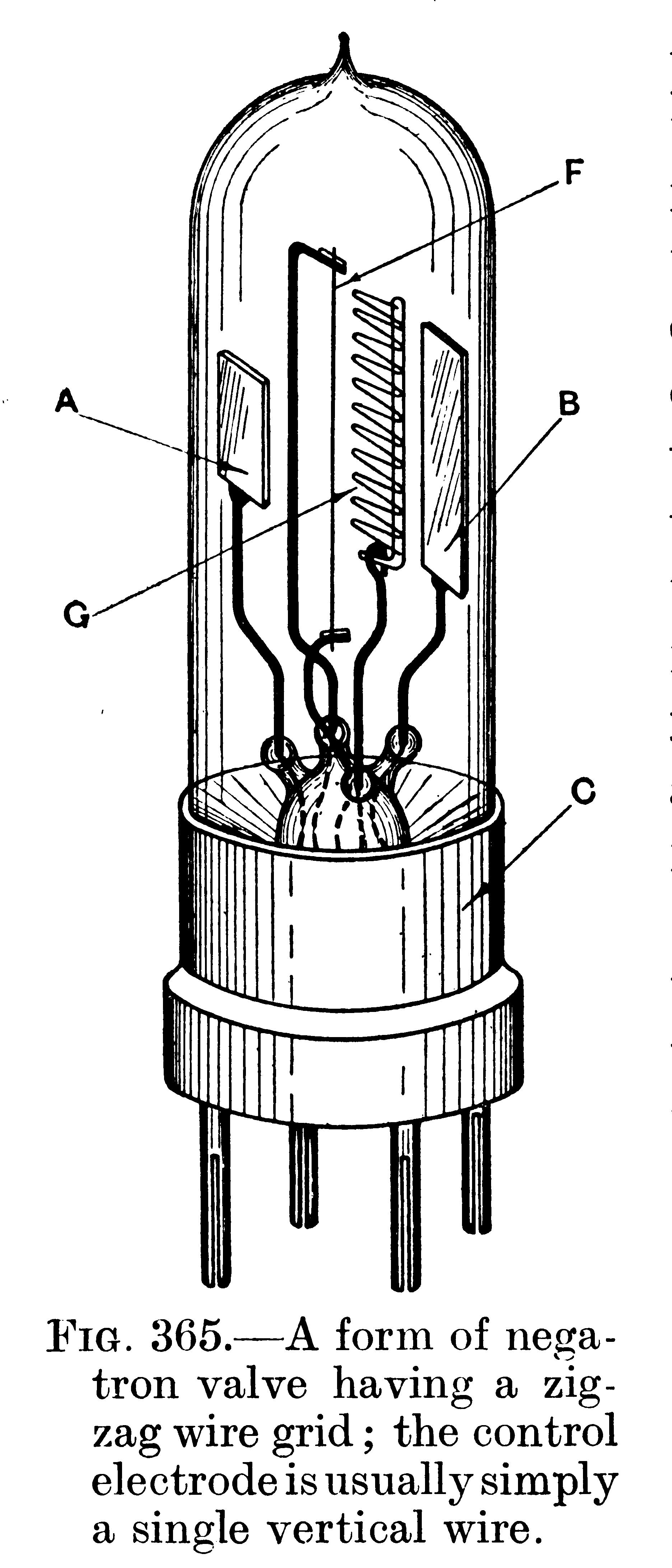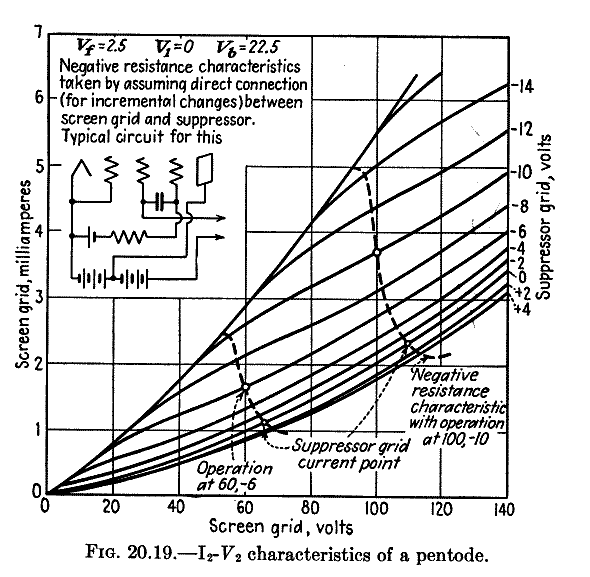The Scott-Taggart Negatron oscillator from 1921 can be seen as the predecessor of the Transitron oscillator. A comprehensive description is given in "Scott-Taggart, J.: Thermionic Tubes in Radio Telegraphy and Telephony, 2nd ed., Iliffe, 1924".
The Negatron uses the saturation of the cathode current of a special diode-triode system, while the Transitron has a virtual cathode due to space charge in front of the last grid. So far, the physical effects are different, however both concepts produce a Dynatron characteristic without the need of secondary electrons.
The negatron, one of the present author's inventions, is a thermionic tube having two flat anodes, one on each side of a filament. Each anode is connected through an anode battery to the filament so that the electrons emitted by the filament, when it is heated to incandescence, are distributed fairly equally between the two anodes. A control electrode, which may be a flat grid (or sometimes a straight wire acting as a grid), is also arranged within the tube between the filament and one of the anodes. This latter anode will be called the "diversion anode," while the first one will be called the "main anode." If we suitably arrange the relationship between the electron emission and the anode voltages, we may make the sum of the two anode currents approximately equal to the electron emission. In other words, a saturation effect is obtained. Under these conditions, if we make the grid more positive with respect to the filament, we shall divert electrons from the main anode to the diversion anode, with a consequent reduction in the current flowing in the main anode circuit. In the negatron as preferably used, the main anode is connected to the grid so that when the main anode voltage is increased the grid potential is increased, electrons are diverted from the main anode, and the main anode current decreases. Hence the negativ resistance effect.

Fig. 365 illustrates the negatron tube itself. The anode on the left is the main anode (usually small), while the anode on the right is the diversion anode. Between the filament and the diversion is a flat open-work grid. A tubular bulb with a four-pin cap is preferred, the connection to the main anode being taken to the metal portion of the tube cap. A metal spring on the holder presses against and makes electrical contact with this metal portion.

The action of the negatron will be best understood if reference is made to Fig. 366, which shows a negatron connected up in one way so as to possess negative resistance characteristics. Between the anode A and the filament F is a battery B3 and two terminals I-N. Between these terminals a milliameter may, for the time being, be connected. The anode A is connected through a battery B5 to the grid G. This battery is merely connected in this position to keep the grid at a suitable potential, which is preferably slightlynegative. If G were connected directly to A, G would have a high positive potential with respect to F. Between F and the diversion anode B is a second battery B2. Both B3 and B2 are usually of about 60 volts, but their values are not very important provided that the current supplied to the filament F may be adjusted to produce the saturation effect.
Let us now see what will happen if we increase the voltage of B3. We should normally expect the current to A to increase, but as the potential of A increases so does that of the grid G. Since G becomes more positive, the current to B will increase, and this increase could be measured by connecting a second milliameter in the B anode circuit. This method of varying the current to B is, of course, well known, as it has been used in ordinary tubes since the grid was first introduced. The important fact to notice, however, is that if the current to B increases, the electrons which go to B must come from those which would have gone to the anode A. There is, therefore, a diversion of electrons. If the B anode current increases, the A anode current must decrease. Similarly, a decrease of the A anode current would always be accompanied by an increase of the B anode current. This effect is conditional on the existence of saturation in the tube. Since by increasing the potential of the main anode A we have diverted electron current to the anode B, the main anode current decreases.
There are now two effects which govern the A anode current; the increase in the A anode potential tends to increase the A anode current ; the diversion effect, however, tends to decrease the A anode current. The diversion effect greatly outweighs the other, and the result is a decrease in the main anode current consequent on an increase of the main anode potential. A decrease of the main anode potential makes the grid more negative and decreases the current to B ; the A anode current consequently increases. In this way the negatron acts as a negative, resistance.
The negatron, as described, works only when the. saturation effect is obtained. For this reason, a filament current rheostat is desirable, and the current through the filament is adjusted until the negative resistance effect is obtained. If the filament be too bright, there will be no "robbing" action; there will always be a plentiful supply of electrons around the filament, and an increase of grid potential would increase the B anode current, and the additional electrons would come from the source around the filament and not from amongst those which would have gone to the main anode. The A anode current would, therefore, be unaffected and no negative resistance effect would be obtained.

The above explanation is borne out by characteristic curves obtained with the negatron, three of which curves are shown in Fig. 367. The thick line shows the main anode current. The top thin curve shows thesum of the two anode currents. A broken line represents the diversion anode current. As the grid is always kept in the neighbourhood of zero volts, the grid current is almost zero. The grid is usually kept slightly negative, so that the grid current is zero. If this were not so, the grid current would add itself to the main anode current, and the negative resistance slope would be slightly less steep.
The curves of Fig. 367 bring out very clearly the "robbing" action which the negatron utilises. The top curve shows that the negative resistance effect is obtained while the tube is saturated. Since the total current remains constant and the diversion anode current increases (due to the control electrode potential rising), the main anode current must of necessity decrease, and this is shown by the thick line which slopes downwards. The main anode current decreases to the left of the peak because the saturation effect is non-existent (as proved by the top curve), and the decrease in grid potential produces an increase in space-charge circuit. The curve is, of course, only used along its downward sloping portion, and the oscillations will only be produced when the main anode and grid potentials are at suitable values. In practice, the grid potential is usually slightly negative, and no grid voltage adjustment is necessary.
To recount the applications of the negatron would take up too much space. The main use of it is as a generator of continuous oscillations for the transmission or reception of continuous waves. It may be used for receiving spark signals by reducing the effect of positive resistance. As a local oscillator it is exceedingly convenient, as it will oscillate on all ranges from 600 m. to 20,000 m. (the usual commercial range) without any complicated switching arrangements. The circuit arrangements which have been found most convenient are shown in Fig. 368.

These are the same as those in Fig. 366, except that the two batteries are replaced by a single one B2 of about 60 volts. The main anode A is connected through a leaky grid condenser C2 to the grid G, a resistance R1 being connected across grid and filament. This leaky grid condenser merely replaces the battery B5 of Fig. 366 for the purpose of avoiding a high positive grid potential. The filament F is heated by current from the 6-volt accumulator B, through the rheostat R2 of about 7 ohms' resistance. This rheostat is adjusted until continuous oscillations are produced in the oscillatory circuit L1C1. It is to be noted that the diversion anode circuit plays no other part in the circuit than as a path round which electrons are shunted.
It will be of interest, no doubt, to demonstrate by means of curves the fact that the negatron only oscillates over a given range of filament current. Fig. 369 shows a series of characteristic curves ; main anode currents are given for different values of filament current.
The negative resistance effect disappears completely when the filament current is above 0.575 ampere. Likewise, it disappears, for an obvious reason, when the filament current is very small. An oscillatory circuit will oscillate provided conditions are such as to come within the shaded area, and no difficulty is experienced in practice through the limited range of filament brightness.
Regards,
Dietmar
To thank the Author because you find the post helpful or well done.
























